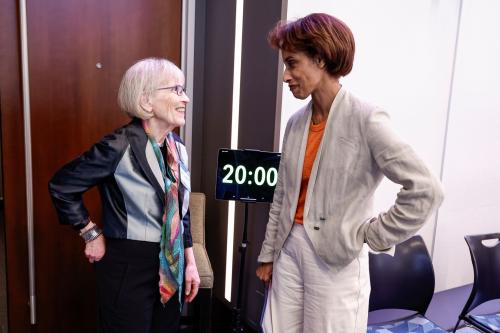State public health departments are on the front lines of ensuring effective responses to challenging problems. In order to be successful at this, accurate information about which activities are supported by relevant evidence must be available to and used by decisionmakers. The extent to which this occurs is driven by a complex interplay of organizational structure, capacity, culture, and priorities. Adjusting any of these can be costly, time-consuming, and risks unintended negative consequences. Thus, in conjunction with our colleagues at the Prevention Research Center at Washington University, we used a sophisticated computational simulation model to identify ways that state public health departments can make changes that increase their effectiveness.
State public health departments serve an essential role in responses to myriad issues, from the ongoing opioid crisis to chronic diseases such as diabetes. However, recently they have faced increasing challenges both in terms of the magnitude of the problems that they confront as well as the politicization of their work; this has been especially highlighted by the recent “stress test” of the COVID-19 pandemic.
As the United States works to invest in and support critical public health infrastructure to face current and future challenges, there are opportunities to revisit how such departments are structured and managed. Empirical evidence from the last decade shows significant room for improvement in allocation of resources due to what we refer to as “mis-implementation,” i.e., the ending of activities whose effectiveness is supported by evidence or the continuation of activities that are not. In a study recently published in the American Journal of Preventive Medicine, we examine why this might occur and how incidences of mis-implementation might be meaningfully reduced as part of the rebuilding of public health capacity in our country.
Research by ourselves and others indicates that premature termination of activities supported by evidence is primarily due to lack of funding. Overall funding is largely beyond the control of public health officials in the short to medium term. The reasons underlying continuation of ineffective programs are less clear, and a central focus of our new study. Discontinuing ineffective activities can free up room in budgets for things that have positive impact and make public health more efficient.
We developed a computational simulation of a representative public health department, examining how organizational structure, training, information sharing, and leadership practices shape decision-making around which programs to continue. This animation illustrates the computational model that we use and its key findings:
Based on computational simulation results, there is only minor motivation to invest in evidence-based assessment training or collaborative communication strategies beyond the levels of these currently found in health departments. However, a large increase in the effectiveness of active programs and interventions can be obtained by changing the way that leadership makes continuation decisions. Most of this gain comes from simply removing intervention longevity from consideration during the decision-making process. That is, beyond other considerations, there is a tendency to continue programs that have been active for longer based on an implicit or explicit assumption that this is itself evidence of effectiveness. Instead, it would be useful for leadership to always view interventions with “fresh eyes” when they decide whether to continue them.
Fortunately, there is an expansive array of training resources that can help leaders avoid the “sunk cost fallacy” when making decisions that drive inefficient organizational inertia. Based on our research, we recommend that health departments allocate time and resources to this relatively easy and potentially highly impactful adjustment.
The Brookings Institution is financed through the support of a diverse array of foundations, corporations, governments, individuals, as well as an endowment. A list of donors can be found in our annual reports published online here. The findings, interpretations, and conclusions in this report are solely those of its author(s) and are not influenced by any donation.
-
Acknowledgements and disclosures
Chris Miller provided video narration and editorial comments on the text. This project is funded by the National Cancer Institute of the NIH (R01CA214530, P50CA244431), the Centers for Disease Control and Prevention (Number U48DP006395), and the Foundation for Barnes-Jewish Hospital.







Commentary
Improving the effectiveness of public health efforts
Evidence from computational simulations
February 1, 2023